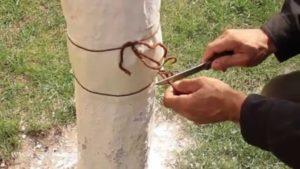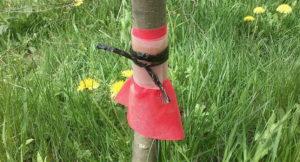Do-it-yourself hunting belts for fruit trees: 6 reliable designs
In pest control, all means are good. Fruit crops suffer from insects very much, especially in hot weather. Various bugs, caterpillars and spiders move to the crown and tasty fruits not only with the help of wings, but also “on their own”. On their way, a hunting belt can become an obstacle - a reliable trap that is easy to make with your own hands.
Content
What is a trap belt

Trapping belt.
The name of this method speaks for itself. A trapping belt is a trap that is put on the trunk of a plant in order to catch insects. It is a kind of strip, a belt that prevents movement.
They can be different - handmade and homemade, and the design itself can be a simple obstacle or a method of destruction. This method is simple and safe, and can be used when chemistry is inappropriate.
Who can be caught
Naturally, insects that fly from place to place cannot be caught with an ordinary belt. However, many of them pupate on the ground, and this fact is to our advantage. Just when they are climbing up the trunk of a tree in search of food, our trap will help. Get into the hunting belt:
How to use traps correctly
The simple requirements of using traps for every, even the most inexperienced gardener, will help protect plants.
- They are installed at a height of about 30-50 cm. Not lower than the grass level.
- It is best to fix the trap at the very beginning of spring, even before the insects wake up.
- Frequently check traps for fullness, change them if necessary.
- Fasten as tightly as possible so that not a single small bug gets through.
Purchased hunting belts
You can not think about your own work and buy a finished design. This will facilitate the work and help those who do not have enough time or even do not have a special desire to make something. Of course, everyone can choose and purchase for themselves those traps that will be to their taste. But here are a few that, in my subjective opinion, are credible.
Hunting belts made by yourself
There are varieties of hunting belts that you can make yourself. They are completely simple or cunning, with baits. But to make them within the power of everyone, almost any of the presented mechanisms.
Primitive funnel
This mechanism works simply, quickly and effectively. For manufacturing you will need:
- thick paper or cardboard;
- twine or rope;
- plasticine or sticky material.
Production is simple to the point of impossibility:
- The barrel is wrapped with paper so that the funnel comes out, with the wide side down.
- The top should fit snugly, it needs to be smeared so that there is no passage.
- Fasten around the trunk, pressing down with a rope.
It works simply and flawlessly. Insects get into the funnel, but they cannot get out. Periodically it is necessary to check for filling.
complex funnel
The lower part is made according to the same principle, and the same funnel is made up. But a cloth impregnated with insecticide is placed in the upper part. So insects that will descend from above will fall into a trap and die. You need to check such a mechanism more often than usual.
Collar
A slightly more tricky mechanism that only needs to be done if properly prepared. To create a gate trap, you need:
- soft rubber;
- glue that can hold it together;
- butter.
It is necessary to make the press so that it is as tightly attached to the trunk as possible. Step by step manufacturing process:
- Measure the barrel and cut the elastic so that it fits as tightly as possible. Please note that the width should be 30-40 cm.


Rubber belt.
- Wrap the barrel and connect the rubber, it is best to glue it, but options are possible.
- The bottom of the gum, which is held very tightly, pull up to form a roller.
- Place sunflower or machine oil inside.
- Periodically add liquid to the funnel and remove dead pests.
tight belt
The process is simple, although the view is not very pleasant. Works quickly and efficiently. The barrel is tightly wrapped with glass wool or foam rubber, and fixed with a stretch film, tape or any other material.
The principle of operation is simple - insects get into the dense material and get stuck there. They die because they can't get out. You need to change more often than the previous types, every 10-14 days.
sticky trap
This method is often combined with the previous ones, but can also be used separately. All beetles get caught in Velcro and die there. For cooking, you only need a base to wrap around the trunk and sticky layer.
- The material is wrapped around the trunk and firmly fixed.
- Coated with sticky glue or other material.
- As it dries, it needs to be changed.
- Stoke or burn filled traps to destroy pests.
What glue to use
Purchased adhesives can be used. But gardeners can do it on their own. There are three different recipes.
Rosin and castor oil should be mixed in a ratio of 5: 7, boiled over low heat for 1-2 hours until it thickens.
Heat up 200 g of vegetable oil, add 100 grams of resin and grease to it, mix and heat.
Cook mistletoe berries slowly, stirring, until you get a homogeneous gruel. Strain and add a little oil to the mucus.
poison trap
This is a trap impregnated with a liquid insecticidal preparation, like Aktara or Iskra. Soak a part of the fabric with a solution of a chemical preparation, fix it on the trunk. It is necessary that the fabric be wrapped with a film that will prevent evaporation.
It is better to change the belt once a month, and impregnate as it dries.
Pros and cons of a trap belt
As with any method, the use of trapping belts has its advantages and disadvantages. To be fair, both sides should be mentioned.
Positive:
- the method is simple;
- cheap;
- effectively;
- easy to do.
Negative:
- the need to change;
- the weather can spoil;
- adhesive material cannot be applied to wood;
- beneficial animals suffer.
When to put on and take off
The design will be effective throughout the season if it is installed in a timely manner. Those funnels that are made double-sided act both on those that climb a tree and on those that crawl to the ground to lay eggs.
Conclusion
Trap belts on fruit trees are a good way to simply and safely protect trees from pests. I hope that with the help of my tips and advice, everyone can easily make a simple but effective mechanism.
Previous

